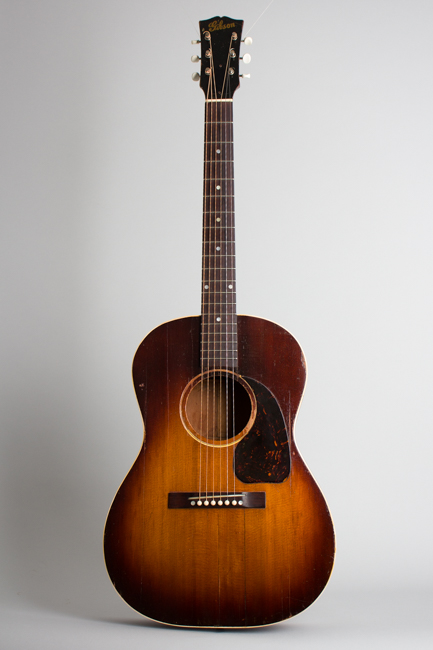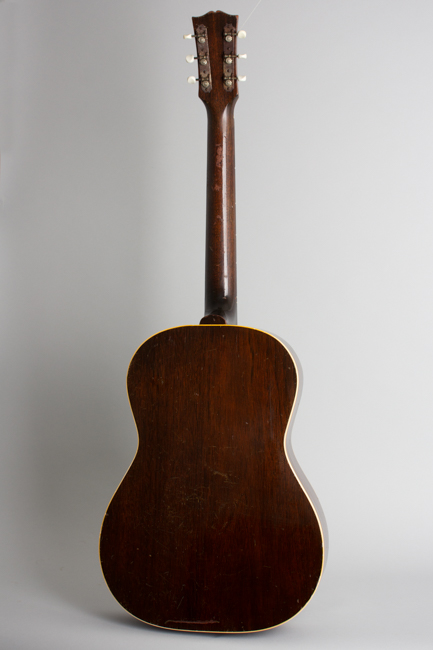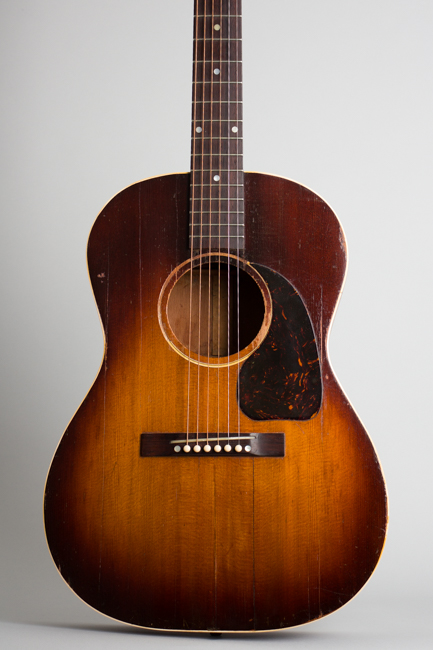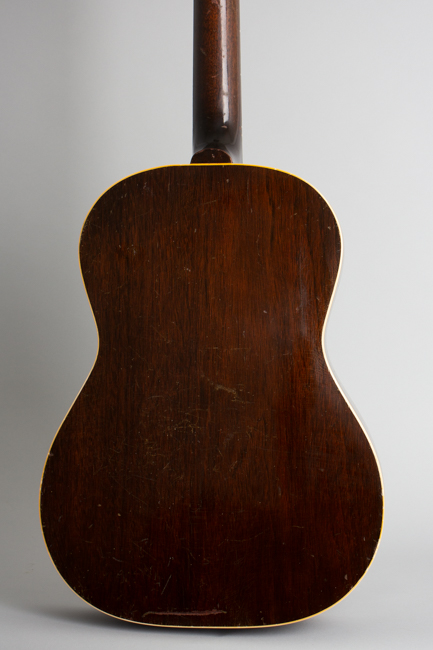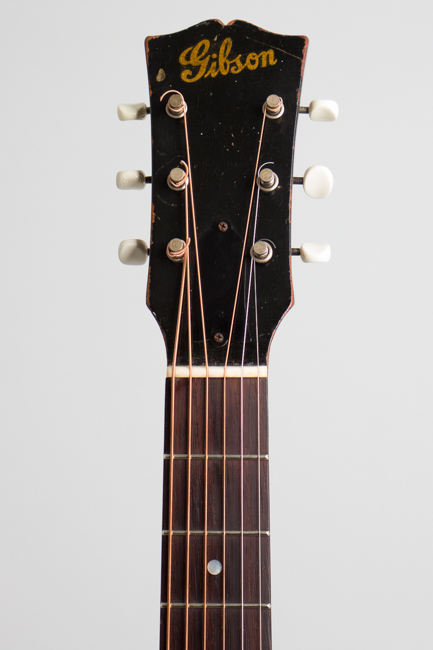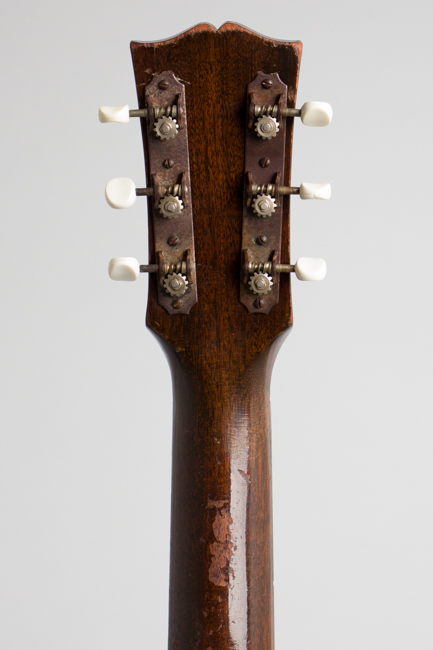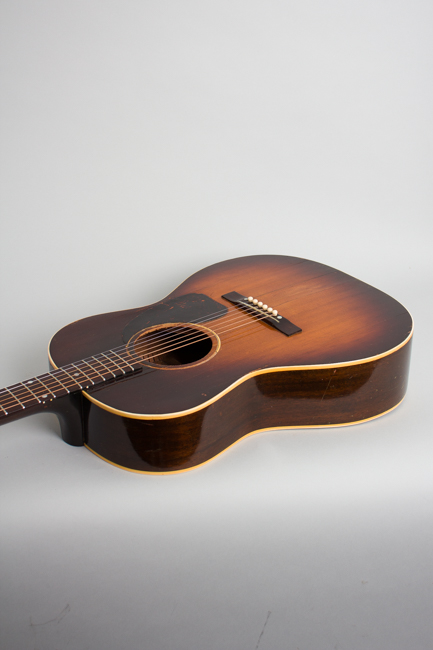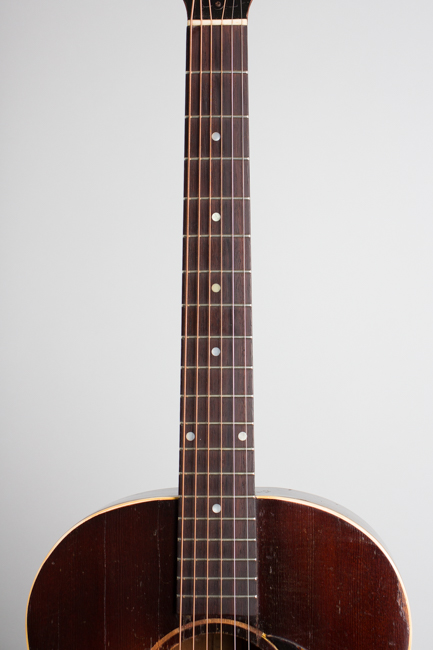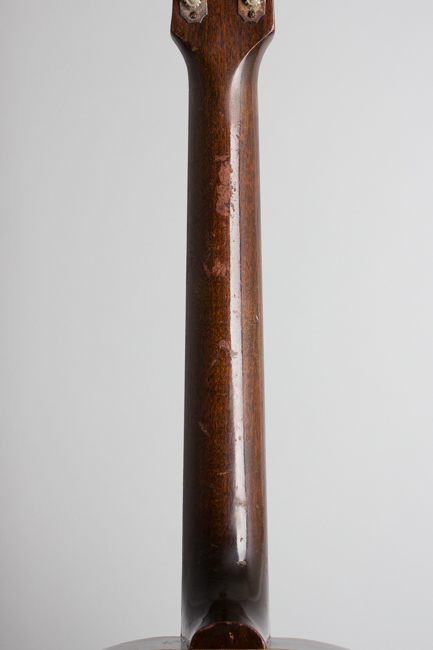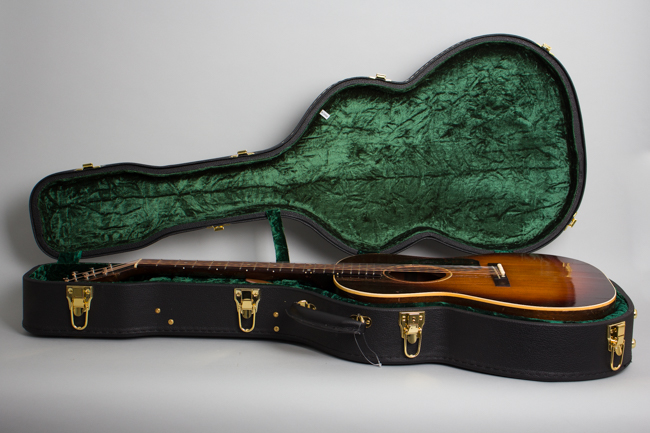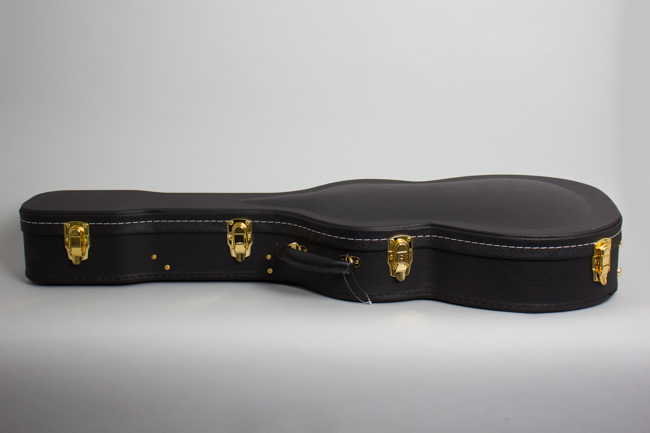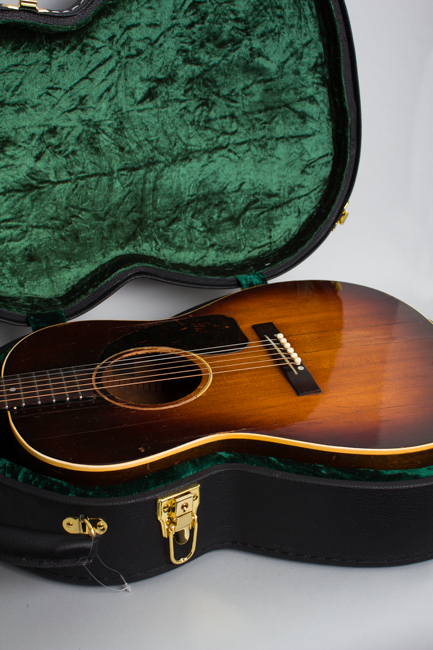Gibson LG-2 Flat Top Acoustic Guitar , c. 1946-7
This item has been sold.
Item # 11267
Prices subject to change without notice.
Gibson LG-2 Model Flat Top Acoustic Guitar, c. 1946-7, made in Kalamazoo, Michigan, sunburst top, dark stained back and sides finish, mahogany back, sides and neck, spruce top, rosewood fingerboard, black hard shell case.
This is a well-used but good playing just post-WWII example of the LG-2, Gibson's most popular smaller body flat-top from the 1940s and '50s. It shows quite a few repairs but is still solid and sweet sounding 75 seemingly hard-lived years on. Oddly enough it does not show as much play wear as many, but has seen some hard times along the way.
The LG-2 was the middle model of a three-instrument line with the externally identical but ladder-braced LG-1 below it and the natural-finish LG-3 positioned above. Exact production figures from this period are lost, but in 1948-50 the LG-2 sold roughly 1000 instruments a year. The first post-war ones like this are somewhat scarcer than later examples, suggesting they were built in smaller numbers as Gibson was just getting back up to speed after doing mostly war work for 4 years.
For some reason lost in Gibson history these 1946-48 flat tops have no serial or factory order numbers, so can only be dated by the features. This one appears to be a fairly early example bearing the gold script logo that disappeared by 1948. Other typical features include a fairly deep orangey sunburst top finish, dark mahogany back and sides, small tortoise celluloid pickguard, small rectangle bridge and single-bound top and back.
The headstock is tapered in depth, still with WWII pattern riveted-gear Kluson tuners fitted. The truss-rod equipped neck has a lovely round-backed "C" profile, substantial feeling but slimmer than many thick wartime "baseball bat" necks and quite comfortable. This is a smooth sounding and versatile guitar, easy playing and warmer sounding than some, a good player's example from Gibson's early post-war period.
Overall length is 39 1/2 in. (100.3 cm.), 14 3/8 in. (36.5 cm.) wide at lower bout, and 4 1/2 in. (11.4 cm.) in depth at side, taken at the end block. Scale length is 24 3/4 in. (629 mm.). Width of nut is 1 11/16 in. (43 mm.).
This LG-2 has had a bit of a herd life, showing a lot of repairs primarily to the top and some general wear. It has been in action a long time, since well before the Korean War! The top has a number of long spruce grain splits, two above the soundhole running the full length of the top, another through the upper soundhole area running almost uninterrupted to the back edge. Behind the bridge are four more of these, two extending above the bridge as well. There are two more grain splits on the lower bout closer to the treble side, and a deeper crack running along the bottom edge of the pickguard. There is one other shore grain split alongside the fingerboard to the forward soundhole edge. All of these are solidly sealed, some decades ago by the look of it but plainly visible.
The back has one small sealed crack and one very deep scrape, the sides and neck are crack free. The finish is largely the original lacquer with some typical checking and a well aged patina overall. There are dings, scrapes and scratches overall but less pick wear than many, only really notable on the lower soundhole rim through the lacquer into the wood. There is some topical touch up on some of the crack repairs. A tailpiece was mounted long ago and the holes on the rim remain. The back of the neck has some feelable dings but not the deep capo wear often seen. In one oddity we rarely see, almost half of the Celluloid soundhole ring is missing.
Internally as would be expected there are numerous signs of work, both antique and recent. There are a number of mostly small and neatly done cleats to the top. The main X brace is original, some smaller braces are more recent re-creations. There has been some brace re-gluing but everything is solid. The original small maple bridgeplate is intact, the bridge appears original but has been lowered and reglued, the retaining bolts are long gone. A couple of pieces of the backstrip lining are missing.
The neck has never been reset; the fingerboard has been neatly trued and refretted with a new bone nut. The original WWII-era tuners have been neatly re-buttoned, the strips show noticeable corrosion. Amazingly enough there has never been a strap button added. Although a bit of a "junkyard dog" in terms of its lifetime of repair, this is an really excellent playing and sounding instrument, a very friendly smaller-bodied guitar with a lovely sound and a really cool vibe. Overall Very Good Condition.
This is a well-used but good playing just post-WWII example of the LG-2, Gibson's most popular smaller body flat-top from the 1940s and '50s. It shows quite a few repairs but is still solid and sweet sounding 75 seemingly hard-lived years on. Oddly enough it does not show as much play wear as many, but has seen some hard times along the way.
The LG-2 was the middle model of a three-instrument line with the externally identical but ladder-braced LG-1 below it and the natural-finish LG-3 positioned above. Exact production figures from this period are lost, but in 1948-50 the LG-2 sold roughly 1000 instruments a year. The first post-war ones like this are somewhat scarcer than later examples, suggesting they were built in smaller numbers as Gibson was just getting back up to speed after doing mostly war work for 4 years.
For some reason lost in Gibson history these 1946-48 flat tops have no serial or factory order numbers, so can only be dated by the features. This one appears to be a fairly early example bearing the gold script logo that disappeared by 1948. Other typical features include a fairly deep orangey sunburst top finish, dark mahogany back and sides, small tortoise celluloid pickguard, small rectangle bridge and single-bound top and back.
The headstock is tapered in depth, still with WWII pattern riveted-gear Kluson tuners fitted. The truss-rod equipped neck has a lovely round-backed "C" profile, substantial feeling but slimmer than many thick wartime "baseball bat" necks and quite comfortable. This is a smooth sounding and versatile guitar, easy playing and warmer sounding than some, a good player's example from Gibson's early post-war period.
Overall length is 39 1/2 in. (100.3 cm.), 14 3/8 in. (36.5 cm.) wide at lower bout, and 4 1/2 in. (11.4 cm.) in depth at side, taken at the end block. Scale length is 24 3/4 in. (629 mm.). Width of nut is 1 11/16 in. (43 mm.).
This LG-2 has had a bit of a herd life, showing a lot of repairs primarily to the top and some general wear. It has been in action a long time, since well before the Korean War! The top has a number of long spruce grain splits, two above the soundhole running the full length of the top, another through the upper soundhole area running almost uninterrupted to the back edge. Behind the bridge are four more of these, two extending above the bridge as well. There are two more grain splits on the lower bout closer to the treble side, and a deeper crack running along the bottom edge of the pickguard. There is one other shore grain split alongside the fingerboard to the forward soundhole edge. All of these are solidly sealed, some decades ago by the look of it but plainly visible.
The back has one small sealed crack and one very deep scrape, the sides and neck are crack free. The finish is largely the original lacquer with some typical checking and a well aged patina overall. There are dings, scrapes and scratches overall but less pick wear than many, only really notable on the lower soundhole rim through the lacquer into the wood. There is some topical touch up on some of the crack repairs. A tailpiece was mounted long ago and the holes on the rim remain. The back of the neck has some feelable dings but not the deep capo wear often seen. In one oddity we rarely see, almost half of the Celluloid soundhole ring is missing.
Internally as would be expected there are numerous signs of work, both antique and recent. There are a number of mostly small and neatly done cleats to the top. The main X brace is original, some smaller braces are more recent re-creations. There has been some brace re-gluing but everything is solid. The original small maple bridgeplate is intact, the bridge appears original but has been lowered and reglued, the retaining bolts are long gone. A couple of pieces of the backstrip lining are missing.
The neck has never been reset; the fingerboard has been neatly trued and refretted with a new bone nut. The original WWII-era tuners have been neatly re-buttoned, the strips show noticeable corrosion. Amazingly enough there has never been a strap button added. Although a bit of a "junkyard dog" in terms of its lifetime of repair, this is an really excellent playing and sounding instrument, a very friendly smaller-bodied guitar with a lovely sound and a really cool vibe. Overall Very Good Condition.
